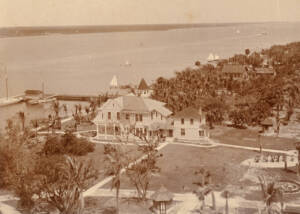



What Flagler discovered in St. Augustine was poor tourist housing and transportation, which he decided to fix by building grand hotels and improving train travel. He quickly built the Ponce de Leon Hotel, followed by two others. He also purchased the Jacksonville, St. Augustine, and Halifax Railroad, which would become the basis for his railroad empire as he expanded Florida’s railway system down the east coast.

When Flagler first visited Lake Worth in 1892, the entire area around the 22-mile-long lake was referred to as Lake Worth; the city by the same name would not exist for many years.

Flagler, a guest in the elegant home of Frederick and Marsena Nelson Robert, was so struck by the beauty of Lake Worth that he bought land on both sides of the lake. Word spread of his activities, setting off a small boom. People invested in land wherever Flagler did, increasing prices as much as 60%, and brought in existing businesses or started new ones.
Most of Palm Beach County’s grand hotels—in a different class than the modest inns of the pioneer era—were built in a flurry of construction between 1893 and 1925. The first two were by Henry Flagler: The Royal Poinciana Hotel in Palm Beach was located just south of the present Flagler Memorial Bridge. The Palm Beach Inn (now The Breakers) followed a few years later just across the island. James A. McGuire and Joseph E. McDonald, Flagler’s contractors, had also built his Ponce de Leon Hotel in St. Augustine.

The Flagler Era evokes the grand living of the Gilded Age in the United States, a period of quick population growth from immigration, extreme industrial expansion that created great wealth, and lavish displays of that wealth, from about 1877 to 1890. But the Gilded Age did not come to Palm Beach until 1894, when the rest of America was still suffering through the Depression of 1893. Flagler not only provided a reason for wealth to come to south Florida, but also a railroad to get it here.

